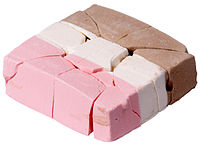
Photo from wikipedia
Abstract To achieve intelligent control of the drying terminal point in pulse-spouting microwave freeze drying (PSMFD) of raspberries, low-field nuclear magnetic resonance (LF-NMR) was used to monitor the moisture status… Click to show full abstract
Abstract To achieve intelligent control of the drying terminal point in pulse-spouting microwave freeze drying (PSMFD) of raspberries, low-field nuclear magnetic resonance (LF-NMR) was used to monitor the moisture status and moisture content changes during drying. As expected, three states of water were observed: bound water, immobile water and free water (around 18, 187, and 1304 ). From the T2 spectrum, the bound water content was observed not to change significantly (p > 0.05), while its proportion gradually increased, and the contents of non-flowing water and free water decreased significantly (p
Journal Title: Journal of Food Engineering
Year Published: 2021
Link to full text (if available)
Share on Social Media: Sign Up to like & get
recommendations!